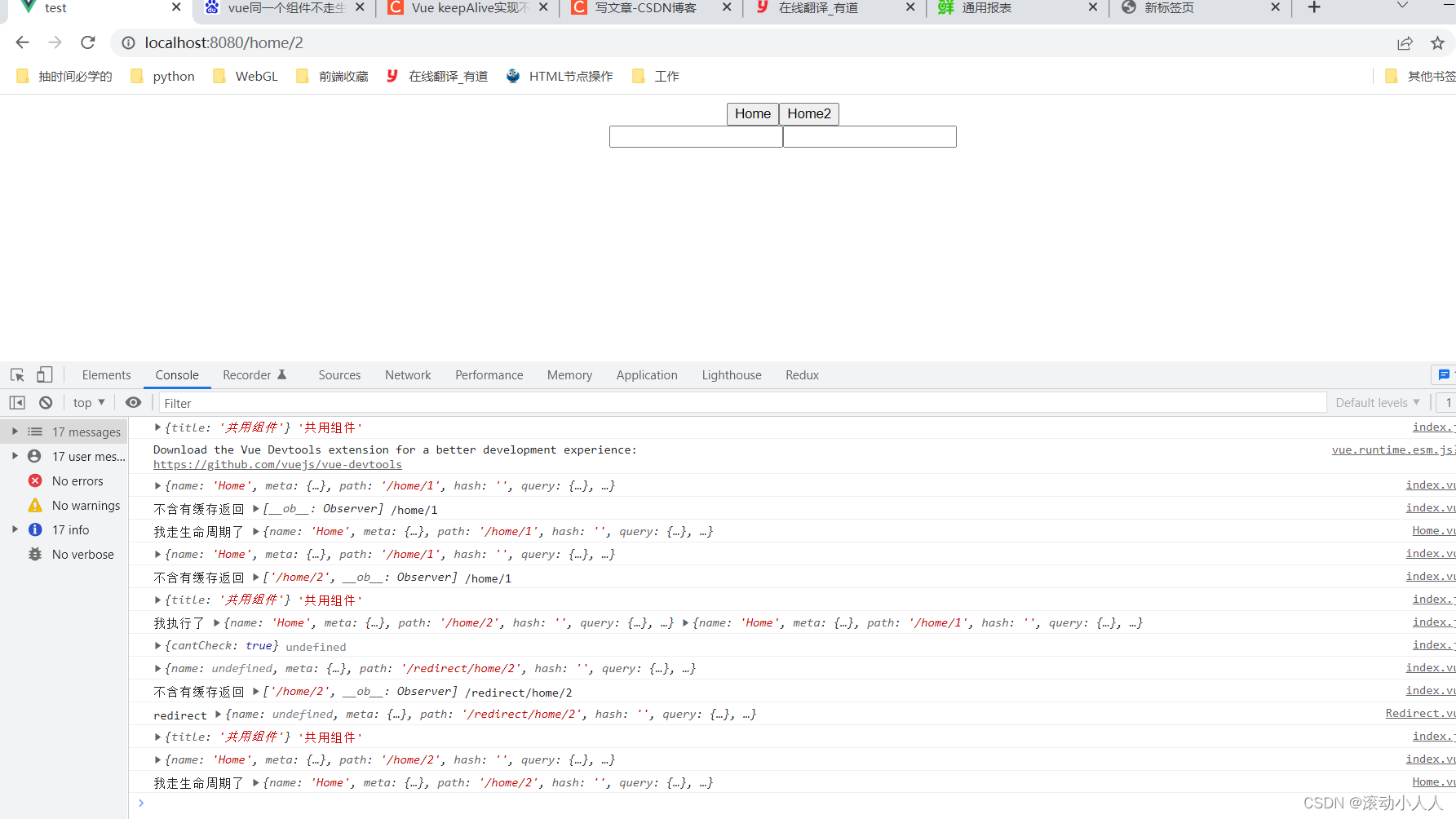
vue中不同路由共用同一个组件,缓存数据。不同路由第一次进入走加载,二次缓存
背景:后端根据不同路由返回不同数据,使用一个组件去渲染页面需求:一,每次新路由进入的同一个组件都要走生命周期,获取后端数据。二,第二次点击需要缓存数据,希望之前输入的数据还在。难点说明:1,由于vue设计时,同一个组件二次进入是不会再次走生命周期,目的是为了提高渲染效率等2,keepAlive缓存同一个组件 会出现不生效的问题解决:关于一:解决方法网上但部分是根据路由在添加一个时间作为key来解决
背景:后端根据不同路由返回不同数据,使用一个组件去渲染页面
需求:一,每次新路由进入的同一个组件都要走生命周期,获取后端数据。二,第二次点击需要缓存数据,希望之前输入的数据还在。
难点说明:
1,由于vue设计时,同一个组件二次进入是不会再次走生命周期,目的是为了提高渲染效率等
2,keepAlive缓存同一个组件 会出现不生效的问题
解决:
关于一:解决方法网上但部分是根据路由在添加一个时间作为key来解决。
但我今天的解决办法是一二一起解决。
首先,先解决为什么keepAlive不能缓存同一个组件?
这里查看源码:keep-Alive.js 的render函数。由于key是相同的,所以每次缓存都会返回相同的vnode节点
render () {
const slot = this.$slots.default
const vnode: VNode = getFirstComponentChild(slot)
const componentOptions: ?VNodeComponentOptions = vnode && vnode.componentOptions
if (componentOptions) {
const name: ?string = getComponentName(componentOptions)
const { include, exclude } = this
if (
// 不再白名单里面的
(include && (!name || !matches(include, name))) ||
// 在黑名单里面的
(exclude && name && matches(exclude, name))
) {
return vnode
}
const { cache, keys } = this
// 这里的key 就是为什么不能缓存同一个组件的关键
const key: ?string = vnode.key == null ? componentOptions.Ctor.cid + (componentOptions.tag ? `::${componentOptions.tag}` : '')
: vnode.key
if (cache[key]) {
vnode.componentInstance = cache[key].componentInstance
remove(keys, key)
keys.push(key)
} else {
cache[key] = vnode
keys.push(key)
// prune oldest entry
if (this.max && keys.length > parseInt(this.max)) {
pruneCacheEntry(cache, keys[0], keys, this._vnode)
}
}
vnode.data.keepAlive = true
}
return vnode || (slot && slot[0])
}所以这里我们需要重新构建一个新的keep-alive ,目的是能够随心所欲的使用key去缓存不同的vnode节点。
目录结构:
外层代码:
<style scoped>
.page-view {
height: 100%;
}
</style>
<script type="text/jsx">
import BlKeepAlive from "./BlKeepAlive";
export default {
name: "PageView",
functional: true,
props: {
include: {
type: Array,
default: () => [],
},
},
render(h, context) {
const { include } = context.props;
return (
<BlKeepAlive include={include}>
<transition mode="out-in">
<router-view />
</transition>
</BlKeepAlive>
);
},
};
</script>
BlKeepAlive代码
<script>
function isEmpty(...str) {
return str.some((i) => i === undefined || i === null || i === "");
}
function getFirstComponentChild(children) {
if (Array.isArray(children)) {
return children.find(
(c) =>
!isEmpty(c) &&
(!isEmpty(c.componentOptions) || (c.isComment && c.asyncFactory))
);
}
}
function removeCache(cache, key) {
const cached = cache[key];
cached && cached.componentInstance && cached.componentInstance.$destroy();
delete cache[key];
}
function getRouterViewCacheKey(route) {
// 这里可以控制自己想要的key
return route.path
}
export default {
name: "bl-keep-alive",
abstract: true,
props: {include: Array},
created() {
this.cache = Object.create(null);
},
beforeDestroy() {
for (const key of Object.keys(this.cache)) {
removeCache(this.cache, key);
}
},
render() {
const slot = this.$slots.default;
const vnode = getFirstComponentChild(slot);
let componentOptions = vnode && vnode.componentOptions;
if (componentOptions) {
const child =
componentOptions.tag === "transition"
? componentOptions.children[0]
: vnode;
componentOptions = child && child.componentOptions;
if (componentOptions) {
const key = getRouterViewCacheKey(this.$route)
const { cache,include } = this;
if (include && !include.includes(key)) {
console.log('不含有缓存返回',include,key)
return vnode
}
if (cache[key]) {
child.componentInstance = cache[key].componentInstance;
} else {
cache[key] = child;
}
child.data.keepAlive = true;
}
}
return vnode || (slot && slot[0]);
},
};
</script>然后:解决从新加载页面和起到缓存作用,还有一个关键点,需要在路由 beforeEach中做一个中转跳转。就是对于相同组件,每次进入都需要先跳转到中转页面,在从中转页面跳回目标页面。
这样不经可以让同一个组件走生命周期,在缓存时也会正确返回缓存页面。
路由:
import Vue from "vue";
import VueRouter from "vue-router";
const Home = () => import("../views/Home.vue");
const Redirect = () => import("../views/Redirect");
Vue.use(VueRouter);
const routes = [
{
path: "/home/:id",
name: "Home",
meta: {
title: "共用组件",
},
component: Home,
},
{
path: "/redirect",
name: "Redirect",
component: Redirect,
children: [
{
path: '*',
component: Redirect,
meta: {
cantCheck: true
}
}
]
},
];
const router = new VueRouter({
mode: "history",
base: process.env.BASE_URL,
routes,
});
/**
* @description: 在进入路由前验证各种状态
* @param {type}
* @return:
*/
router.beforeEach((to, from, next) => {
console.log(to.meta,to.meta.title)
if (to.meta.title !== undefined && to.meta.title === from.meta.title) {
next(`/redirect${to.path}`);
} else {
next();
}
});
export default router;
路由beforeEach,先判断是否是同一个组件,如果是先回重定向到redirect页面。
重定向Redirect代码:
<script>
function replaceAll(str, substr, replacement) {
if (str == null) return str
return str.replace(new RegExp(substr, 'gm'), replacement)
}
export default {
mounted() {
const {path} = this.$route
this.$router.replace(`${replaceAll(path, '/redirect', '')}`)
},
render: h => h()
}
</script>至此:核心代码都写完了,重写keepAlive和增加了一个重定向。这样就可以解决同一个组件,根据不同的路由,第一次进入刷新,第二次进入缓存
后面贴出调用代码:这里是demo所以我直接在app里面写了
<template>
<div id="app">
<div id="nav">
<router-link to="/home/1">
<button @click="goUrl('/home/1')">Home</button>
</router-link>
<router-link to="/home/2">
<button @click="goUrl('/home/2')">Home2</button></router-link
>
</div>
<bl-page-view :include="myInclude">
<router-view />
</bl-page-view>
</div>
</template>
<script>
import BIPaveView from "./components/BIPaveView/index.vue";
export default {
name: "App",
components: {
"bl-page-view": BIPaveView,
},
data() {
return {
myInclude: [],
};
},
methods: {
goUrl(url) {
let arr=[].concat(this.myInclude)
if (!arr.includes(url)) {
arr.push(url);
}
this.myInclude=arr
},
},
};
</script>
<style lang="less">
#app {
font-family: Avenir, Helvetica, Arial, sans-serif;
-webkit-font-smoothing: antialiased;
-moz-osx-font-smoothing: grayscale;
text-align: center;
color: #2c3e50;
}
</style>
公共组件
<template>
<div class="home">
<input
v-for="(item, index) in inputArr"
:key="index"
type="text"
v-model="item.num"
/>
</div>
</template>
<script>
export default {
name: "Home",
data() {
return {
inputArr: [],
pageCode: 1,
};
},
created() {
console.log("我走生命周期了", this.$route);
this.pageCode = this.$route.params.id * 1;
this.clearData();
this.getNewData();
},
methods: {
clearData() {
this.inputArr = [];
},
getNewData() {
let ss = {
1: [{ num: "" }],
2: [{ num: "" }, { num: "" }],
};
this.inputArr = ss[this.pageCode];
},
},
};
</script>
实现效果:
视频暂时未审核:https://live.csdn.net/v/191810
不知这个地址你们可以访问不。反正就是演示了第一次加载后,输入数据再次进入会缓存


更多推荐
 已为社区贡献6条内容
已为社区贡献6条内容







所有评论(0)